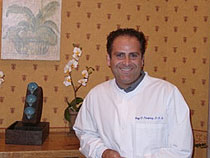
Call it by its fancy name, “halitosis,” and it won’t smell any sweeter. Bad breath is frequently a sign that you’re not keeping up with your oral health. The source of this unpleasant odor is, in most cases, bacteria living on your teeth, gums or tongue. Follow these ten tips from
Dr. Ray Partovy for a breath of fresh air:
1. Brush your choppers twice each day. Better yet, brush after every meal. If you eat lunch at work or school, keep an extra toothbrush there. Also, be sure to replace your toothbrush regularly. Every few months, swap your brush for a fresh one.
2. Reach between your teeth. Flossing daily helps you remove food particles from between your teeth, where your toothbrush just can’t reach. Flossing also helps keep your gums healthy, preventing periodontal disease, which can also lead to bad breath. If using regular floss is difficult for you, try one of the many interdental cleaners available at drugstores.
3. Pick up a water pick. Along with floss, a water pick reaches spots your toothbrush can’t, like under your tongue and into the back of your mouth.
4. Treat your tongue right. Bacteria can gather on the surface of your tongue, so use a soft-bristled toothbrush or a tongue scraper to clean it every time you brush.
5. Tap your inner teenager and chew gum. The act of chewing (sugarless!) gum stimulates the production of saliva, which naturally washes away bacteria and food particles. If you suffer from a lack of saliva due to “dry mouth,” a condition sometimes caused by medication, let your dentist know; he or she can help address the problem.
6. Don’t fall for the myth of mouthwash. Most mouthwashes merely mask the smell of bad breath and don’t do anything to solve the underlying problem.
7. Hydrate, hydrate, hydrate. Drink water regularly to keep your mouth moist, and go easy on alcohol and caffeine, both of which are dehydrating.
8. Turn off the tobacco. Smoking and chewing tobacco lead to bad breath. They also increase your risk of a host of serious health problems, from periodontal disease to cancer.
9. Take note of what you take in. Certain diets, foods and medications can affect your breath. If your problem doesn’t appear to be oral, make a list of the foods you eat and medications you take. Review it with your dentist or your family doctor to assess the source of the problem.
10. Call in the experts. It’s important to have your teeth professionally checked and cleaned twice a year. Your dentist can give your teeth a thorough cleaning that isn’t possible at home, as well as check for and treat early signs of problems such as cavities or periodontal disease.
In rare cases, persistent bad breath can be a sign of a larger health problem. The American Dental Association lists possible medical sources of bad breath, including respiratory infection, chronic sinusitis, postnasal drip, chronic bronchitis, diabetes, gastrointestinal disturbance, and liver or kidney ailments. If your dentist suspects that your breath problem stems from a medical issue, he or she will recommend speaking with your family doctor immediately.
Hope this helps! From
Dr. Ray Partovy
 Dr. Partovy, Marina Del Ray's premier Invisalign provider in 2009, has been successful in giving amazing smiles to both teens and adults. Dr. Partovy and his team will create your individual treatment plan using Invisalign's clear, custom-molded aligners to solve a range of issues, without disruption to your daily life! These services include:
Dr. Partovy, Marina Del Ray's premier Invisalign provider in 2009, has been successful in giving amazing smiles to both teens and adults. Dr. Partovy and his team will create your individual treatment plan using Invisalign's clear, custom-molded aligners to solve a range of issues, without disruption to your daily life! These services include:

















































